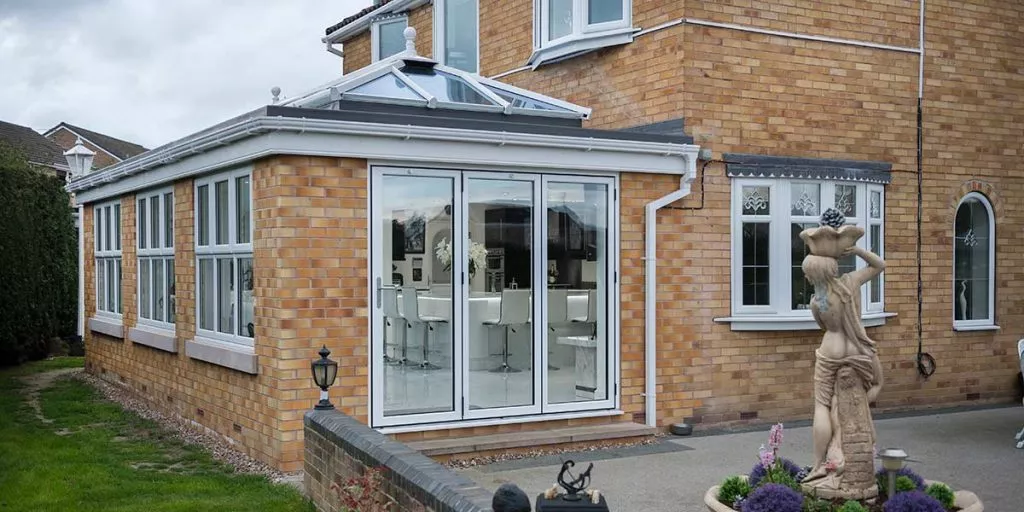Orangery vs conservatory – which one is right for you? Conservatories and orangeries offer the option of additional space at home. Orangeries, with more brickwork, provide a natural extension feel with less glass for privacy. Conservatories prioritise views with extensive glass and can sometimes be a fully glazed structure with a glass roof, maximising sunlight with thermally efficient frames. Choosing between an orangery and conservatory depends on personal preference and what you’re going to do with the space.

What is an Orangery?
Unlike conservatories, orangeries tend to have less glazing and more brickwork in the walls of the structure. They are a brick structure with large windows.
Many homeowners appreciate the natural extension feel that an orangery provides, as it seamlessly integrates with the existing structure of the house.
The careful choice of brickwork is crucial to ensure the orangery looks like an authentic extension rather than an afterthought, and this is something our advisors can help with. While glass is still a prominent feature, its reduced presence compared to conservatories offers added privacy and a balance of warmth.
Advantages
- Because an orangery is a largely brick-built structure, it will fit in with home architecture more naturally than a conservatory.
- Potentially, it could raise the valuation of your property by anything from 5% up to 15%.
- Orangeries can come in a lot less expensive than traditional conservatories.
- Design flexibility is afforded, enabling you to have a feature door integrated and many other personalised touches.
Disadvantages
Although an orangery has abundant glazed facets, it attracts slightly less natural light than a conservatory receives.
- It requires a larger investment to buy a new orangery than a new conservatory.
- Orangery construction is lengthier than building a basic conservatory.
Do Orangeries Add Value to a House?
Orangeries can add significant value to a house. Their distinctive architectural design and integration with the existing structure enhance the overall appeal and functionality of the property.
Unlike conservatories, which may sometimes appear as retrofitted additions, orangeries offer a seamless extension that blends harmoniously with the house’s aesthetic.
With the use of Clearview’s high-quality materials and construction methods ensures durability and longevity, further contributing to the property’s value.
Finally, the versatility of orangeries allows homeowners to utilise the space for various purposes, from dining areas to home gyms, increasing the overall desirability of the property.
What is a Conservatory?
A conservatory is a versatile living space designed to bring the outdoors indoors, maximising sunlight.
Featuring energy-efficient glazing and a fully glazed structure, conservatories boast large, tall windows that allow sunlight to flood the interior, creating a bright and airy atmosphere.
These expansive, large, tall windows not only enhance the aesthetic appeal but also optimise thermal efficiency with energy-efficient glazing by harnessing warmth from the sun, making conservatories comfortable spaces to enjoy throughout the year.
Advantages
An ideal solution for bringing home and garden closer together and strengthening their connection.
- Can be configured into a host of styles, including Victorian, Edwardian, Gable, P-Shaped, T-Shaped and Lean-To designs.
- Gets bathed in natural light and exposure to it is fantastic for your overall wellbeing.
- Utilise the space in whatever you want, whether it’s as a games room, separate lounge or home gym.
Disadvantages
Without energy efficient glazing and an insulating roof, temperature control tends to be poor.
- The transparent glazed surround doesn’t give you much privacy if you’re concerned about onlookers observing the space.
- Some householders find orangeries and extensions more visually alluring.
Do Conservatories Add Value to a House?
Investing in a traditional or UPVC conservatory offers both immediate enjoyment and long-term value appreciation for homeowners. These versatile living spaces not only enhance the overall aesthetic appeal of a property but also increase its market value.
Potential buyers are often drawn to the added living space and connection to the outdoors that conservatories provide, making them a desirable feature in any home. Therefore, they can help make your property stand out from a crowded market.
With their ability to maximise natural light, conservatories contribute to the overall appeal and desirability of a property, ultimately adding value to a property.
The Difference Between a Conservatory and Orangery
As we’ve touched on above, the main difference between orangery and conservatory designs is that a conservatory typically features more glass than an orangery, which instead emphasises brickwork.
However, the distinction between the two can sometimes blur, making it challenging to categorise them definitively.
Contemporary designs have evolved, offering a wide range of styles that may incorporate elements from both conservatories and orangeries, further blurring the lines between the two.
Structural Differences
To tell the difference between an orangery and conservatory take a careful look at the structural composition of the two extension styles.
Orangeries possess brick pillars, multiple solid sections and fewer glass panels than conservatories, which contributes to their rigid and permanent feel.
Conversely, a conservatory has expansive and ample glass panels and a pitched glazed roof that covers over 75% of the overall structure.
These structural distinctions make an orangery more insulated and a conservatory brighter and have a more open atmosphere.
Conventions are evolving though, with lots of modern conservatory and orangery designs blurring the lines between the two, hybrid solutions that incorporate features of each extension type.
Insulation and Energy Efficiency
In any orangery vs conservatory debate, you must touch upon how each type of structure handles insulation and energy efficiency as internal warmth is critical if year-round useability is to be achieved.
Due to their profuse brickwork, orangeries offer a moderately enhanced standard of insulation and are therefore more energy-efficient and comfortable from day to day.
While more prone to temperature fluctuations, with modern double or triple glazing conservatories can provide exceptional thermal efficiency.
Uplift comfort further with blinds or curtains and the integration of underfloor heating if you want a warmer living environment.
Reflect on these factors when considering which extension to buy and based on what the intended functionality of the space will be.
Planning Permission and Regulations
Clearview won’t commence constructing a conservatory or orangery at your home until we have ascertained whether planning permission and building regulations approval is needed first so that no rules are broken, and the extension is lawful.
When evaluating a conservatory vs orangery, awareness of where either planning permission or building regulations applies could sway you in the direction of one or the other.
Larger orangeries will generally be subject to planning permission and building regulations and the same goes for those destined for homes located in a conservation area.
They cannot exceed the tallest point of your home’s roof or go beyond eight metres away from the rear wall of a detached property or six metres in the case of a semi-detached or terraced house to give you an example of the size restrictions in play.
View our comprehensive article on orangery planning permission.
Conservatories typically fall under permitted development rights, meaning they conform to the guidelines and can be erected without the submission of a planning application.
However, if they exceed certain size limitations or will be built at a period home, permitted development rights may be removed.
Read up on the rules relating to conservatory planning permission.
Should I Buy a Conservatory or an Orangery?
Ultimately, the choice of conservatory vs orangery boils down to personal preference, architectural compatibility, and desired functionality.
When you’re looking at an orangery vs conservatory, our advisors can take you through their typical features and the difference between a conservatory and orangery, however each living space is custom-built so you can take some typical conservatory features and typical orangery features to create your dream space based on the suitability for property style.
Have a look at our Living Spaces page to see a number of orangeries and conservatories that Orion has been responsible for building to help discover which most takes your fancy.
